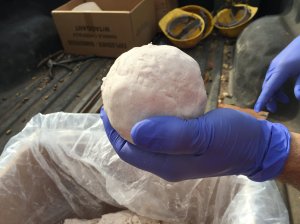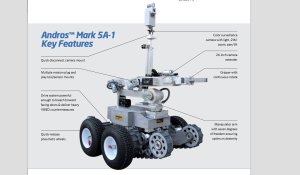Dallas Police Chief David Brown gave an order to his SWAT team after a 45-minute gun battle and two hours of negotiating with a sniper targeting police officers.

He told them to come up with a creative plan to neutralize the suspect without putting another officer in the line of fire.
In the time it took Chief Brown to get back from updating the public about the ongoing battle, his officers had hatched a plan. It would keep them out of the line of fire and take out the suspect.
“They improvised this whole idea in about 15, 20 minutes — extraordinary,” Chief Brown says.
By the time the chief gave the go ahead, at least two officers had already been killed, and several more gravely wounded. Three more would later die from their injuries.
The sniper was targeting police officers, particularly white officers.
“He was basically lying to us, laughing at us, singing and asking, ‘How many did he get?’ and saying that ‘he wanted to kill more,'” Chief Brown told CNN’s Jake Tapper.
Chief Brown made the final call and carried out a plan law enforcement experts say they’ve never seen done by local officials: Use a robot and a pound of C-4 explosive to take the sniper out.
The fight against military trained sniper

Chief Brown says the robot was used in the building where Johnson was still sniping, intent on continuing to kill.
They’d had the robot for a long while. The Remotec Androx Mark V A-1, manufactured by Northrup Grumman, was purchased by the department in 2008. The robot, which cost $151,000, sustained minor damage to the extension arm and is still functional, the chief says.
Chief Brown says his officers were up against a military trained suspect holed up on the second floor of El Centro Community College building in downtown Dallas.
Eventually the robot was maneuvered behind a “brick wall” with the suspect on the other side, the chief says. The robot was carrying the one pound payload, ready to be detonated.
“A pound of C-4 runs about 20 dollars,” if bought in bulk, explosive expert Matt Barnett of Bonetti Explosives told CNN.
Barnett is in law enforcement but he’s licensed to dispose of unexploded ordnances and has been working with explosive materials since he was a child out in West Texas. He agreed to demonstrate what a pound of C-4 can do when detonated against a wall.
The role of the C-4
The C-4 would likely be placed as close to the wall by the robot as possible for full effect, and quietly moved behind the wall so the sniper wouldn’t notice. If the police could do that, they could likely take out their attacker.
“A pound of C-4 is a lot” if it’s detonated inside a building, Barnett says. “It can do a lot more damage to the human body in an enclosed space than outside in the open air.”
“There are two things that’ll kill you with explosives,” Barnett says. “You have over pressure and fragmentation.”
“Fragmentation is the one we worry about most and usually that’s the number one killer with explosives,” Barnett says. “The fragments becomes like little missiles.”
They can go through a human body like “butter,” he says.
Over pressure would burst blood vessels and make a person dazed and confused, Barnett explained. They may not appear to be injured at first. But inside they are bleeding out.
Barnett fashions a pound of C-4 into a ball, then a brick shape with his gloved hands and secured in onto a two-by-four to simulate the robotic arm. The C-4 is pushed snug up to the concrete. A charge is placed inside the soft C-4 brick.
CNN is not detailing the other key steps to achieve the desired explosion.
When the blast occurs, it pierces the relatively quiet 100-plus acres in West Texas where the demonstration was conducted. It can be felt from behind a car, and more than a football field away.
Part of the brick wall is pulverized into dust but some of it is still standing.
But there is no doubt that anyone standing behind it would suffer grave injuries or death from the fragments.
Dallas police were hoping their tactic would work against a suspect who had taken so many lives. It did.
The chief faced some criticism for using what is seen by some as war tactic in a civilian setting.
But he was unequivocal when asked whether he would make that choice again.
“This wasn’t an ethical dilemma, for me. I’d do it again to save our officers,” Brown says.
The robot’s role
While detailed specifics were not revealed about many of the robot’s movements prior to the explosion in Dallas, some of its capabilities give insight into what officers might have been able to see, hear or do with it.
The 790-pound robot can be mounted with a variety of sensors, cameras, and attachments. Its arm, once fully extended, can lift 60 pounds and the end can grip with 50 pounds of force, according to manufacturer documents.
It is capable of riding over ditches, over rough terrain, climbing stairs and can traverse through openings up to 24 inches wide and obstacles up to 16 inches tall, according to the manufacturer.
The tactical robot has a 26x optical zoom, a 12x digital zoom and two-way communication, enabling it to send back real time status, positioning and images.
Robots are common inside police departments, but generally used to disable explosive devices or disorient and incapacitate suspects that are barricaded.
It generally carries a flashbang, a device that emits a bright light and loud sound. Sometimes these robots are used to place an explosive near a bomb in order to disarm it via explosion.
But there are far more uses for the robot, depending on what accessories you choose to pair it with.
Northrop Grumman Remotect’s site details a variety of options of mounts to attach other tools to the robot including:
A modified 12 gauge shotgun, which can also be used as a breaching tool
A gas can dispenser mount
A window breaker
A cable cutter
Drills and saws
Real time x-ray machines
Mounts to combine with L6, L8 37mm or 40mm launcher weapons
While it is unknown if Dallas police specifically possess any of these accessories, or other law enforcement departments in the U.S., the use of the robot and explosives is likely to continue to be a topic of interest and scrutiny.
The Dallas chief says he’d use the robot or other unconventional tactics again in a similar situation.
“I would use any tool necessary to save our officers’ lives,” Brown says. “And I’m not ashamed to say it.”





